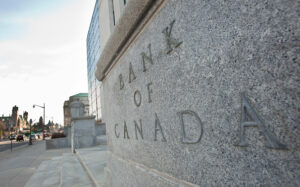
The Bank of Canada building in Ottawa on April 12, 2011. (Photo by GEOFF ROBINS/AFP via Getty Images)
The Bank of Canada is hiring a product architect as it continues to move forward with its “contingency plan” for a central bank digital currency (CBDC), leading some to speculate about the potential consequences.
A digital currency is a hot topic south of the border, as the U.S. public awaits the imminent release of a Federal Reserve paper on its own CBDC. While the idea may be new to Americans, the Bank of Canada has been issuing reports on the concept since November 2016.
A year ago, the bank co-authored a report with six other central banks and the Bank of International Settlements to establish foundational principles and core features of a CBDC. In February 2021, the bank published three CBDC proposals: one from the University of Calgary, another from McGill University, and a joint University of Toronto and York University submission.
In an email to The Epoch Times, Bank of Canada spokesman Alex Paterson said the proposals were made to stimulate thought.
“[T]he proposed designs are not intended to be adopted by the Bank. Rather, the Bank will use these reports to inform its thinking and advance public conversation on a central bank digital currency design,” Paterson wrote.
Bank leadership has consistently said it’s only trying to be prepared and a digital currency is not a sure thing. Governor Tiff Macklem told the media in April that the decision ultimately lies with the finance minister, adding, “if we were to issue a digital currency, we wouldn’t stop printing cash.”
Still, the bank is taking steps toward bringing a product to market. In August, it issued a job posting for a product architect for “a program of major social significance to design a contingent system for a central bank digital currency (CBDC), which can be thought of as a banknote, but in digital form.”
According to the posting, part of the job would be to “craft a coherent product architecture and design that will be a fit at a national scale and adaptable for decades.”
Potential Sweeping Changes to Banking
According to Université du Québec à Montréal economist Steven Ambler, a CBDC would have broad implications.
“Central banks could potentially compete unfairly with commercial banks by offering higher rates of interest or charging smaller fees and use seigniorage revenue—ultimately our tax dollars—to subsidize this unfair competition,” Ambler said in an interview.
“Commercial banks would be forced to rely less on deposits for their financing, potentially making them behave more like investment banks.”
Seigniorage refers to the interest earned on a bank note minus the cost of producing, distributing, and replacing that note.
Should central banks take on more liabilities as a result of issuing the CBDC, Ambler says they would have to acquire more assets. This would either involve assuming a greater portion of government debt or taking an active role in the economy, like the Federal Reserve has done in the United States.
He noted, however, that central banks tend to be wary of digital currencies and “what could happen if demand for their national currency disappeared in favour of something else—some cryptocurrency or some version of a stablecoin—this would involve a loss in monetary control.”
Concerns About Privacy and Control
China’s central bank has issued its own digital currency, which state-run Global Times said will help challenge “U.S. dollar hegemony.” Meanwhile, it has banned bitcoin. In April, hedge fund manager Kyle Bass told NTD Television, an affiliated network of The Epoch Times, that the move is a means of controlling the Chinese people domestically but could one day also be used against foreign investors.
“If you think [Chinese leader Xi Jinping] is a terrible ruler, all of sudden, your global social credit score gets whacked and the Chinese can actually stop your ability to spend the money,” Bass said.
“This is a way they can export their digital authoritarianism around the world, and it’s something that we must stop.”
Some believe Western countries will get left behind if they don’t have a domestic version of China’s digital yuan, but others disagree. In a recent interview with Kitco News, Canadian businessman and entrepreneur Kevin O’Leary downplayed the development.
“What person outside of China would ever put that on their balance sheet? That thing as far as I am concerned is toxic waste. I wouldn’t touch it and so I would never impute any value to it. I don’t like having a single individual in a foreign government deciding who can own it, who cannot, and having a track on it because that blockchain is going to let them know that I own it. No thanks,” O’ Leary said.
“[We will] still be talking about this 20 years from now. I think what’s more likely to happen is that they [the U.S. Federal Reserve] will regulate issuers of stablecoins as banks.”
Although Ambler believes “a desire to be able to monitor people’s transactions more closely” is part of the motivation for a CBDC, he doubts any democratic government would or could ban bitcoin or physical cash.
“I personally think ways of escaping surveillance and control will exist, and if governments try to become too authoritarian, I think they won’t be able to, although … one of the things that COVID has taught me is that people have a very high demand for safety—even at the expense of individual rights and freedoms,” he said.
Sweden, one of the countries where digital payments are increasing the fastest, has an option of inserting a tiny computer chip under the skin of the hand, which can be used for certain transactions. So far around 3,000 Swedes have had a microchip implanted.
